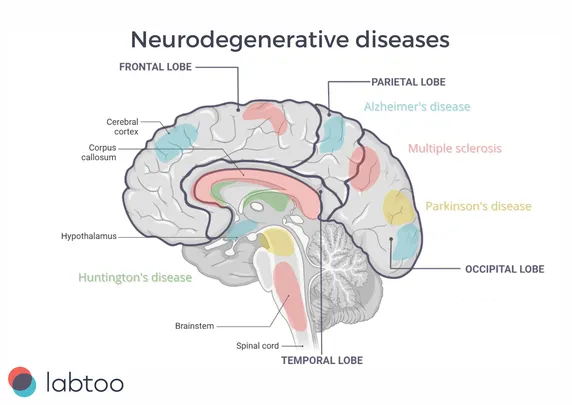Neurodegenerative disorders: Research and Therapies
Nov 8th 2022, by Labtoo's team
Neurodegenerative diseases affect almost 50 million people worldwide. It remains a mystery in the research and the medical fields and for most of them, there exists no permanent cure. But not all hope is lost, especially since the latest research and technology offer therapies and rehabilitation services that improve symptoms, increase mobility, and enhance the quality of life of patients and family members.
Neurodegenerative diseases
Neurodegenerative disorders encompass a wide range of conditions caused by progressive damage to cells and nervous system connections that are essential for mobility, coordination, strength, sensation, and cognition. Neurodegenerative disorders are characterized by progressive loss of neurons, which contrasts with select static neuronal loss because of metabolic or toxic disorders.
The nerves in our bodies are very similar to electric cables. The brain and spinal cord send electrical signals through the nerves to different muscles. The muscles, in turn, have a specialized mechanism to properly understand the electrical signals and act, accordingly, thus moving different parts of the body.
There are different types of neurodegenerative disorders such as Alzheimer’s disease, ataxia, Huntington’s disease, Parkinson’s disease, Motor neuron disease, multiple system atrophy, and progressive supranuclear palsy. The most frequent neurodegenerative condition is Alzheimer’s disease.

Diagnosis
Electromyography (EMG)
Electromyography is a technique for evaluating and recording the electrical activity produced by muscles. EMG is performed using a machine called the electromyograph, to produce a record called an electromyogram. The recording is then used to detect the tiny amount of electricity generated by muscle cells when they are activated by the nerves connected to them. Specialists analyze these signals to detect medical abnormalities in the spinal cord, nerves, and the muscles that are connected to specific nerves. There are two types of EMG:
- Intramuscular EMG is the most common. It involves inserting a needle electrode through the skin into the muscle that is being studied.
- Surface EMG(SEMG) involves placing electrodes on the skin over the muscle to detect the electrical activity of the muscle. It is not used as often because it provides less useful information than intramuscular EMG.
Nerve Conduction Velocity (NCV)
An electrical diagnostic test that provides information about abnormal conditions in the nerves. Nerves are stimulated with small electrical impulses by one electrode while other electrodes detect the electrical impulse "downstream" from the first electrode. The resulting nerve impulses are then measured. The NCV test is often done at the same time as the EMG in order to exclude or detect both nerve and muscle conditions.
Electrocardiogram (EKG) & Electroencephalogram (EGG)
An electrocardiogram records the electrical signals in the heart. It's a common and painless test used to quickly detect heart problems and monitor the heart's health. As for the electroencephalogram, it is used to record the brain's continuous, electrical activity through electrodes attached to the scalp.
Potential treatments
Despite significant attempts to find drugs that can permanently eradicate the symptoms of tauopathies such as Alzheimer's disease and Parkinson's disease, discovering safe and effective therapeutics for neurodegenerative disorders has proven difficult due to complicated and poorly understood molecular pathways. There are currently no drugs to prevent or cure neurodegenerative disorders and no effective therapeutics to treat neurodegenerative diseases.
However, medications to control symptoms can be very effective. There are also other approaches to manage symptoms and maintain daily activities such as physiotherapy, speech pathology, occupational therapy, and psychiatry.
Nevertheless, research to find new treatments for neurodegenerative disorders is still ongoing. One of the most promising treatments uses stem cells to replace the neurons that have died.
Furthermore, a number of in vitro and in vivo models exist for studying neurodegenerative diseases, including cell models employing induced-pluripotent stem cells, cerebral organoids, and animal models of disease.
For more information about our solution at Labtoo, check our page dedicated to biological samples sourcing from patients with neurological disorders.
Source: